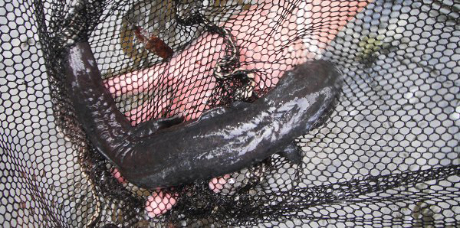Research team is hell-bent on saving hellbenders
By Sheri Englund

Snot otter. Devil dog. Mud devil.
The eastern hellbender – a freshwater salamander that can grow to more than two feet long – has a collection of folksy aliases and oversized charisma. The giant amphibians are native to New York and other eastern states, but today you’d be lucky to see one in the wild. Over the past decade, hellbenders have nearly disappeared from New York watersheds.
In 2009 biologists from the New York State Department of Environmental Conservation (NYSDEC) launched a captive rearing-and-release program to save New York’s vanishing hellbenders. Working with the Buffalo Zoo, they raised hundreds of baby hellbenders and released most in the Allegheny area. Unfortunately, the majority of these healthy captive-reared animals died in the wild – and no one was sure why.
Wildlife veterinarian Elizabeth Bunting and a troubleshooting team of Cornell colleagues joined the project early this year to investigate. Support from the Atkinson Center’s Rapid Response Fund allowed the researchers to delay the scheduled release of the remaining captive hellbenders and set up a lab for disease testing. Bunting and her team worked with NYSDEC to develop a monitoring plan. This past summer, they reintroduced 25 hellbenders to the wild in large cages, where they could be examined and tested for several months.
The news is not good: So far, 19 have died. Bunting and her team confirmed that a fungus is the culprit.
“They are succumbing to overwhelming chytridiomycosis, a fungal disease of amphibians that is killing species worldwide,” she said. Chytrid fungi have been linked to dramatic population declines and extinctions of frogs and other amphibian species. The newly released hellbenders are especially vulnerable to the disease.
“While we knew that wild hellbenders in the same area were infected with the fungus, we assumed that not all of the captive released animals would become exposed right away,” Buntin explained. “If they did, we expected that they would mount some kind of resistance, as the wild animals tolerate infection fairly well. This appears not to be the case. Without any prior exposure these captive animals are rapidly infected and don’t survive.”
This vital piece of detective work may save the remaining 130 hellbenders still waiting at the Buffalo Zoo. Bunting’s team recently applied for additional funding to study how wild hellbenders’ skin helps them resist the chytrid fungus in their environment.
“We plan to do some trials over the winter to essentially vaccinate the captive hellbenders, to see if there is an improvement in survival after exposure to dead chytrid,” Bunting said. “This kind of information is critically important for the progress of captive rear-and-release programs for endangered amphibians.”
The Cornell team’s ongoing work to save the memorable amphibian with the funny names also promises to help frogs and salamanders around the world resist and survive exposure to deadly chytrid fungi.
Sheri Englund is science writer and editor at Cornell's David R. Atkinson Center for a Sustainable Future.
Media Contact
Get Cornell news delivered right to your inbox.
Subscribe